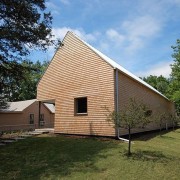Pt II: Questions to Ask the Admissions Office
Part II of our series: An Application Guide to Architecture School
Today, we are highlighting a few questions that you should ask admissions offices when considering which school to choose for your undergraduate or graduate degree.
What degree programs do you offer in architecture and related fields?
Associate degrees (A.A., A.S., A.A.S): This 2-year degree can be an entry point directly into the architecture workforce or a starting point to gain some foundational skills and transfer to a 4-year institution. It is not NAAB accredited and will not satisfy the education requirement for initial licensure.
Bachelor of Art or Science in Architecture (B.A. or B.S. in Architecture, Architectural Studies, Environmental Design, Architectural Engineering…etc.): This 4-year degree is a common precursor to the NAAB accredited M.Arch. It develops a comprehensive knowledge of the discipline of architecture but is not NAAB accredited and will not satisfy the education requirement for initial licensure in most states. If you’re unsure about becoming a licensed architect, one of these degrees could still encompass everything you enjoy about design and construction.
Bachelor of Architecture (B. Arch): This 5-year degree is the most popular undergraduate degree that will satisfy the education requirement for initial licensure. Students develop a comprehensive knowledge of the discipline of architecture as well as foundational professional knowledge and a basic understanding of related fields. Most of the 55 U.S. licensing boards require that architects hold a professional degree from a NAAB-accredited program and this is the only undergraduate NAAB accredited architecture degree offered in the U.S.
Master of Architecture (M.Arch): This 2-year or 3-year degree is a graduate level degree and can be paired with a B.A or B.S. in Architecture or a bachelor degree in a non-related field. This is the most popular graduate degree that will satisfy the education requirement for initial licensure. A student will develop an understanding of architecture including knowledge of the academy and the profession as well as some level of specialization.
Master of Science (M.S. in Architecture): This 1-year or 2-year degree is a graduate level degree and is commonly a post-professional degree, meaning it comes after the completion of a B.Arch or an M.Arch. It is usually research focused and predicated on independent inquiry. It is not NAAB accredited and will not satisfy the education requirement for initial licensure.
Doctor of Architecture (D.Arch): This 3-year or 4-year degree is a graduate level degree and, much like the M.Arch, can be paired with a B.A or B.S. in Architecture or a bachelor degree in a non-related field.
Are there any additional admissions requirements?
Many schools require an additional major-specific ? essay, but some schools of architecture also require students to submit a portfolio. A portfolio is a collection of your design work to date. This traditionally includes architectural drawings, photography, models, technical solutions or other artistic mediums. A few schools also recommend students participate in on-campus interviews.
Do you have an estimate of any additional expenses that are not included in tuition and fees?
Often times architecture students are required to purchase a specific laptop, a drafting board, and/or specific software and art supplies. Some schools require students to travel for studio projects and other schools require a semester of study in another country. It is a good idea to plan ahead for these expenses and add these expenses into your total cost of attendance. If you are hoping to save money, a good follow up question would be about the availability of computers and materials available for students to use free of charge.
What policies do you have to ensure student wellbeing?
The truth is, architecture schools are notorious for being rigorous and time intensive. Schools know this and should be able to articulate measures they take to ensure students are managing the balance between schoolwork and college life. Each school should have a studio culture policy and should be able to share how they implement that policy. Some schools close studios at certain hours to instill healthy work habits while others offer one-on-one mentoring for students to share successes and failures.
Does this program allow me to gain practical work experience while I am a student?
Depending on degree type, some programs will facilitate work experience. Some schools offer co-op programs that integrate working in an architectural practice as part of your degree and some programs offer the Integrated Path to Architecture Licensure (IPAL). IPAL schools provide a few students with the opportunity to complete the Architectural Experience Program® (AXP®) and the Architect Registration Examination® (ARE®) required for licensure at the same time they are completing the degree.
Does this program offer study abroad or interdisciplinary opportunities?
An architectural education is dependent on a well-maintained balance between how much time you spend studying, and how much time you spend seeking inspiration from the world around you. Traveling outside of the United States can be helpful in finding that balance. Make sure the program you choose encourages opportunities to develop soft skills outside of the classroom because architects have to work well with people outside of their discipline.
Download the Application Guide to Architecture Schools Part I and II as a PDF.
Read Part I of the Application guide here.










